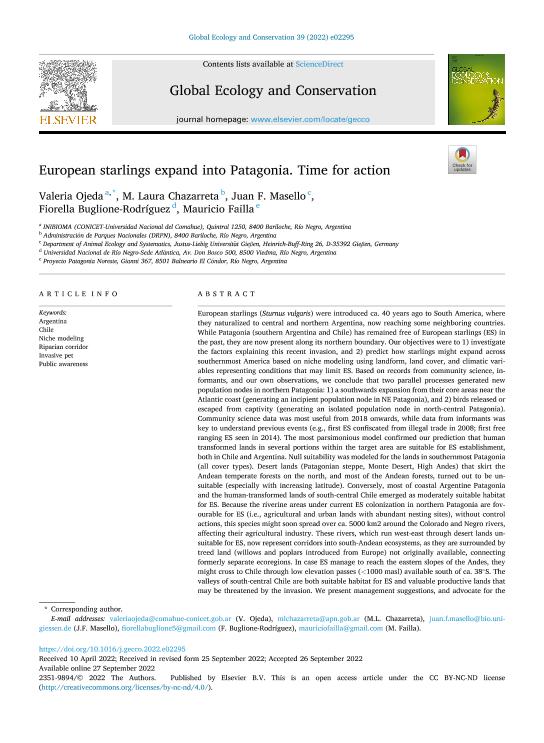Artículo
European Starlings expand into Patagonia. Time for action
Ojeda, Valeria Susana ; Chazarreta, María Laura
; Chazarreta, María Laura ; Masello, Juan F.; Buglione Rodríguez, Fiorella; Failla, Mauricio
; Masello, Juan F.; Buglione Rodríguez, Fiorella; Failla, Mauricio
 ; Chazarreta, María Laura
; Chazarreta, María Laura ; Masello, Juan F.; Buglione Rodríguez, Fiorella; Failla, Mauricio
; Masello, Juan F.; Buglione Rodríguez, Fiorella; Failla, Mauricio
Fecha de publicación:
09/2022
Editorial:
Elsevier
Revista:
Global Ecology and Conservation
ISSN:
2351-9894
Idioma:
Inglés
Tipo de recurso:
Artículo publicado
Clasificación temática:
Resumen
European starlings (Sturnus vulgaris) were introduced ca. 40 years ago to South America, where they naturalized to central and northern Argentina, now reaching some neighboring countries. While Patagonia (southern Argentina and Chile) has remained free of European starlings (ES) in the past, they are now present along its northern boundary. Our objectives were to 1) investigate the factors explaining this recent invasion, and 2) predict how starlings might expand across southernmost America based on niche modeling using landform, land cover, and climatic variables representing conditions that may limit ES. Based on records from community science, informants, and our own observations, we conclude that two parallel processes generated new population nodes in northern Patagonia: 1) a southwards expansion from their core areas near the Atlantic coast (generating an incipient population node in NE Patagonia), and 2) birds released or escaped from captivity (generating an isolated population node in north-central Patagonia). Community science data was most useful from 2018 onwards, while data from informants was key to understand previous events (e.g., first ES confiscated from illegal trade in 2008; first free ranging ES seen in 2014). The most parsimonious model confirmed our prediction that human transformed lands in several portions within the target area are suitable for ES establishment, both in Chile and Argentina. Null suitability was modeled for the lands in southernmost Patagonia (all cover types). Desert lands (Patagonian steppe, Monte Desert, High Andes) that skirt the Andean temperate forests on the north, and most of the Andean forests, turned out to be unsuitable (especially with increasing latitude). Conversely, most of coastal Argentine Patagonia and the human-transformed lands of south-central Chile emerged as moderately suitable habitat for ES. Because the riverine areas under current ES colonization in northern Patagonia are fovourable for ES (i.e., agricultural and urban lands with abundant nesting sites), without control actions, this species might soon spread over ca. 5000 km2 around the Colorado and Negro rivers, affecting their agricultural industry. These rivers, which run west-east through desert lands unsuitable for ES, now represent corridors into south-Andean ecosystems, as they are surrounded by treed land (willows and poplars introduced from Europe) not originally available, connecting formerly separate ecoregions. In case ES manage to reach the eastern slopes of the Andes, they might cross to Chile through low elevation passes (<1000 masl) available south of ca. 38°S. The valleys of south-central Chile are both suitable habitat for ES and valuable productive lands that may be threatened by the invasion. We present management suggestions, and advocate for the development of a bi-national strategy to retard, prevent and alleviate the far-reaching impacts ES may exert on America's southernmost ecosystems and resources.
Palabras clave:
ARGENTINA
,
CHILE
,
INVASIVE PET
,
NICHE MODELING
,
PUBLIC AWARENESS
,
RIPARIAN CORRIDOR
Archivos asociados
Licencia
Identificadores
Colecciones
Articulos(INIBIOMA)
Articulos de INST. DE INVEST.EN BIODIVERSIDAD Y MEDIOAMBIENTE
Articulos de INST. DE INVEST.EN BIODIVERSIDAD Y MEDIOAMBIENTE
Citación
Ojeda, Valeria Susana; Chazarreta, María Laura; Masello, Juan F.; Buglione Rodríguez, Fiorella; Failla, Mauricio; European Starlings expand into Patagonia. Time for action; Elsevier; Global Ecology and Conservation; 39; 9-2022; 1-13
Compartir
Altmétricas



